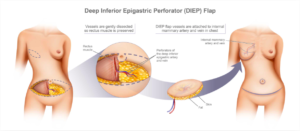DIEP FLAP SURGERY VS.
TRAM FLAP SURGERY
When it comes to reconstructive breast surgery, there are two common, but distinctively different methods that surgeons typically use. One type involves using breast implants during reconstruction, and the other uses soft tissue for breast reconstruction.
While implant surgery is the most common type, there are added benefits to soft tissue procedures such as DIEP flap surgery and TRAM flap surgery.
These procedures are similar since they’re both soft tissue based, but also very different. These differences will determine how you may feel after your surgery, but offer excellent results either way.
WHAT IS A TRAM FLAP?
TRAM is a transverse rectus abdominis, which is a muscle in your lower abdomen between your waist and your pubic bone. A flap of your skin, fat and all, or parts of your underlying rectus abdominus muscle are used to reconstruct the breast in a TRAM flap procedure.
HOW DOES TRAM FLAP BREAST SURGERY WORK?
There are two different ways to approach the TRAM flap procedure. Both give the same results, just two options. A pedicled TRAM is where the surgeon leaves the muscle and the tissue to attach both to the original blood supply in the lower abdomen area and try to maneuver underneath the skin to their new location in the chest. A free TRAM is where those tissues are completely taken away and detached, then reattached to the blood vessels in your armpit area while using advanced techniques.
WHAT ARE THE SIDE EFFECTS?
The side effects of TRAM flap surgery have some significant complications. Each woman’s breast sensation changes. This happens due to the nerves in the woman’s breast changing and can cause her not to feel anything. While the surgery typically takes 6 to 8 hours, keep in mind you are under anesthesia during surgery as well, so it will take additional time for the anesthesia to wear off.
Depending on the condition of the breast, the surgery may take longer. Some women have to get drains placed due to fluid in their breast, which can sometimes play a part in the complications that you can face.
WHAT IS THE RECOVERY TIME?

Recovery from TRAM Flap Surgery requires patients to stay in the hospital for a few days after their surgery.
Extended recovery and healing time is also a factor. You will spend 5 to 10 days in the hospital after the TRAM Flap surgery. The recovery time and each person is different, but the recovery and healing time can typically take 6 weeks to 8 weeks depending on how your body heals.
You will need to wear a compression girdle for up to 8 weeks after the surgery. This is needed because your body just went through a surgery that placed great stress on two parts of your body. The recovery time for each person varies. Some people may heal faster, it’s all about resting and allowing your body to recover from the extensive surgery and changes your body went through during surgery.
DIEP stands for the Deep Inferior Epigastric Perforator artery which runs through your abdomen. DIEP flap is similar to a muscle-sparing free TRAM flap, but also very different due to the fact that no muscle is used to rebuild the breast. A muscle-sparing free TRAM flap uses some muscle. While a DIEP flap is considered a muscle-sparing type of flap which helps the breast surgeon be able to save the patient’s muscles entirely.

HOW DOES DIEP FLAP SURGERY WORK?
During surgery, incisions are made in the same areas as TRAM flap surgery, but no muscle tissue is taken from the donor area. This can be done all at once, or over multiple operations, depending on the needs of the patient. For instance, if a patient still needs radiation therapy after a mastectomy, the patient can schedule their DIEP flap surgery around those appointments.
Because soft fat tissue is taken from the stomach region, this surgery gives you a “tummy tuck” during the reconstruction. Blood vessels are also taken from the donor area, which allows the new breast tissue to stay healthy and natural-looking.
WHAT ARE THE SIDE EFFECTS?
There are always risks after surgery. Specific side effects of DIEP flap surgery relate to the reconstructed tissue and the tissue donor area. Sometimes, the blood supply to the new breast tissue might become tied off or restricted.
When this happens the fat may die and become scar tissue. When this occurs, it is called fat necrosis. If this happens, it does not usually show up until months after the surgery. The scar tissue will feel like a small lump, which will not go away on its own.
Ask your doctor if you do notice a lump in your reconstructed tissue. If you wish, your surgeon can remove these lumps to reduce discomfort.
Another possible side effect of the DIEP flap procedure is blood collecting in the new breast. The body usually will absorb or redistribute the excess blood, but if not, it can be drained by your doctor.
Patients may experience minor nerve damage around the donor site, or around the new breast. Since the incisions typically leave a scar, most plastic surgeons will place the stomach incision below the bikini line in order to reduce visibility.
WHAT IS THE RECOVERY TIME FOR DIEP FLAP RECONSTRUCTION?

Recovery from DIEP flap surgery starts with a few days staying in the hospital, followed by a period where you need to avoid strenuous physical activity.
Patients typically spend about 5 days recovering in the hospital. During your stay, your doctor will drain any fluid that builds up in the new breast. Once the fluid levels have gone down, you will be released.
In order for you to heal properly, you will be required to avoid heavy lifting and high activity levels. The tissue will be more vulnerable during this period, but it should heal within six to eight weeks.
SOFT TISSUE BREAST RECONSTRUCTION COMPARISON:
At the basic level, these procedures accomplish the same thing. Where they differ is in the execution. TRAM flap focuses on using tissue from your abdominal muscles, as well as some soft tissue. DIEP flap spares the abdominal muscle and uses only soft fat tissue and local blood vessels.
Each procedure has long recovery times, and similar side effects. The side effects include tissue necrosis, fluid build-up, lumps showing up in the breast. Additionally, TRAM surgery does come with an added side effect of hernias and muscle weakness at the donor tissue site. If you have any additional questions about either procedure and its side effects, don’t hesitate to ask!
Do I Have to Get Breast Reconstruction Immediately After a Mastectomy?
Breast surgeons and plastic surgeons offer patients the opportunity for immediate breast reconstruction after a mastectomy. However, this option is not always right for every patient. While you’re seeking breast cancer treatment, your oncology team will work together to help you make the decision.
Many patients will choose to undergo immediate breast reconstruction, but others choose to have a delayed breast reconstruction procedure. Like the different types of tissue-based breast reconstruction procedures, each option has advantages and disadvantages.
Immediate Breast Reconstruction
The advantage of getting an immediate breast reconstruction is you get all of the healing out of the way in one go. The disadvantage of this is your body will be put through a longer surgery and will need longer to recover.
Delayed Breast Reconstruction
The advantage of getting a delayed breast reconstruction is your body has more time to heal, and the recovery won’t be as intense as the recovery for immediate breast reconstruction.
Related: Are Breast Implants Safe After A Mastectomy?
Consult Dr. Garza for DIEP Flap or TRAM Flap Surgery
Visit Garza Plastic Surgery today in Nashville, TN to discuss if either TRAM or DIEP flap is an option for you and to learn more about both procedures. We also offer a variety of alternatives and can answer any questions you may have to help find the best solution for your health and beauty goals. Call us today at (615) 620-7800.




